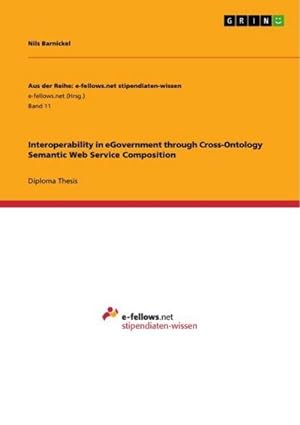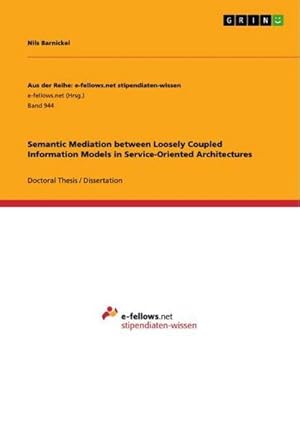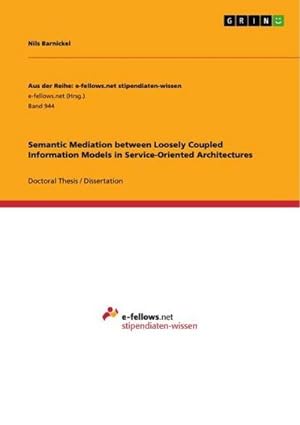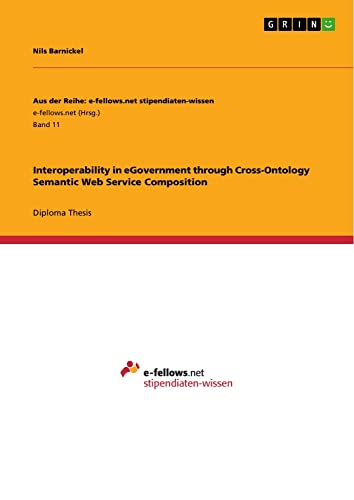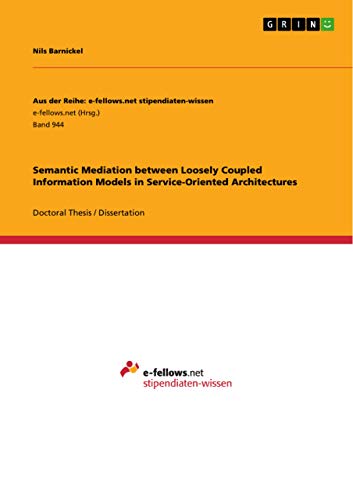Nils Barnickel (6 results)
Product Type
- All Product Types
- Books (6)
- Magazines & Periodicals
- Comics
- Sheet Music
- Art, Prints & Posters
- Photographs
- Maps
-
Manuscripts &
Paper Collectibles
Condition
Binding
- All Bindings
- Hardcover
- Softcover
Collectible Attributes
- First Edition
- Signed
- Dust Jacket
- Seller-Supplied Images (4)
- Not Printed On Demand (4)
Seller Location
Seller Rating
-
Interoperability in eGovernment through Cross-Ontology Semantic Web Service Composition
Published by GRIN Verlag Jun 2011, 2011
ISBN 10: 3640942795ISBN 13: 9783640942794
Seller: BuchWeltWeit Ludwig Meier e.K., Bergisch Gladbach, Germany
Book Print on Demand
Taschenbuch. Condition: Neu. This item is printed on demand - it takes 3-4 days longer - Neuware -Diploma Thesis from the year 2006 in the subject Computer Science - Applied, grade: 1,0, Free University of Berlin (Institut für Informatik), language: English, abstract: Due to the heterogeneous structure of the public sector, the achievement of interoperability is a key challenge for comprehensive electronic government. Service-oriented architectures lay the foundation for flexible application integration and process-orientation through Web service composition. Semantically enriched Web services promise to increase the level of automation and to reduce integration efforts significantly. Furthermore, a relatively high degree of formality in key areas of government activities encourages the application of Semantic Web concepts. This diploma thesis presents an approach for semi-automatically supporting the design and execution of data flows within the composition of semantically described Web services that are making use of different ontologies and data representations. The approach includes a rule-based mechanism for user-transparent mediation between ontologies. In order to validate the approach, a prototypical cross-ontology Semantic Web service composition tool has been implemented to be used in eGovernment scenarios spanning multiple application domains. The essence of this thesis was presented at the European Semantic Web Conference 2006 at the Workshop on eGovernment and Semantic Web and is published in the paper. 96 pp. Englisch.
-
Semantic Mediation between Loosely Coupled Information Models in Service-Oriented Architectures
Published by GRIN Verlag Jul 2014, 2014
ISBN 10: 3656686149ISBN 13: 9783656686149
Seller: BuchWeltWeit Ludwig Meier e.K., Bergisch Gladbach, Germany
Book Print on Demand
Taschenbuch. Condition: Neu. This item is printed on demand - it takes 3-4 days longer - Neuware -Doctoral Thesis / Dissertation from the year 2011 in the subject Computer Science - Commercial Information Technology, grade: Sehr gut, Technical University of Berlin (Fakultät IV - Elektrotechnik und Informatik), language: English, abstract: The last two decades have shown a major shift from stand-alone to networked information technology (IT) systems. Consequently, the effective and efficient achievement of interoperability is a key factor to enable seamless business process chains and networks across intra- and inter-organizational boundaries. Thereby, interoperability can be understood along three dimensions: technical, semantic and organizational interoperability.While the concept of service-oriented architectures (SOA) and widely accepted Web service standards have benefited technical interoperability in recent years substantially, managing and integrating semantic differences in heterogeneous distributed environments remains critical and cost intensive. In order to preserve the precise meaning as data is moved from one IT system to another, explicit formal information models in terms of ontologies have evolved as the concept of choice from academia to first industry adoption. However, it has been recognized that the dominant approach of developing a common, globally shared ontology as an information model standard has turned out to be limited in real world cross-domain environments. Organizational boundaries with regard to consensus degree and the complexity deriving from inherent domain-specific differences in requirements force a coexistence of independently managed but however semantic interoperable information models.In order to address this challenge, the guiding idea of this work is to transfer the principle of loose coupling to the semantic level. In particular, the goal of this thesis is to contribute to the reduction of complexity in semantic system integration by developing an effective and efficient approach for semantic interoperability in large-scale SOA landscapes based on semantic mediation between loosely coupled information models. Moreover, this work shows how emerging semantic technologies can contribute to the instantiation of this concept exploiting their capabilities to explicitly express semantics.The developed approach is evaluated based on a case study of an exemplary distributed organization. It is shown how the approach of semantic mediation between loosely coupled information models can be applied in practice and which benefits can be generated with regard to achieving effective and efficient semantic interoperability in large-scale SOA landscapes. 240 pp. Englisch.
-
Interoperability in eGovernment through Cross-Ontology Semantic Web Service Composition
Published by GRIN Verlag, 2011
ISBN 10: 3640942795ISBN 13: 9783640942794
Seller: AHA-BUCH GmbH, Einbeck, Germany
Book
Taschenbuch. Condition: Neu. Druck auf Anfrage Neuware - Printed after ordering - Diploma Thesis from the year 2006 in the subject Computer Science - Applied, grade: 1,0, Free University of Berlin (Institut für Informatik), language: English, abstract: Due to the heterogeneous structure of the public sector, the achievement of interoperability is a key challenge for comprehensive electronic government. Service-oriented architectures lay the foundation for flexible application integration and process-orientation through Web service composition. Semantically enriched Web services promise to increase the level of automation and to reduce integration efforts significantly. Furthermore, a relatively high degree of formality in key areas of government activities encourages the application of Semantic Web concepts. This diploma thesis presents an approach for semi-automatically supporting the design and execution of data flows within the composition of semantically described Web services that are making use of different ontologies and data representations. The approach includes a rule-based mechanism for user-transparent mediation between ontologies. In order to validate the approach, a prototypical cross-ontology Semantic Web service composition tool has been implemented to be used in eGovernment scenarios spanning multiple application domains. The essence of this thesis was presented at the European Semantic Web Conference 2006 at the Workshop on eGovernment and Semantic Web and is published in the paper.
-
Semantic Mediation between Loosely Coupled Information Models in Service-Oriented Architectures
Published by GRIN Verlag, 2014
ISBN 10: 3656686149ISBN 13: 9783656686149
Seller: AHA-BUCH GmbH, Einbeck, Germany
Book
Taschenbuch. Condition: Neu. Druck auf Anfrage Neuware - Printed after ordering - Doctoral Thesis / Dissertation from the year 2011 in the subject Computer Science - Commercial Information Technology, grade: Sehr gut, Technical University of Berlin (Fakultät IV - Elektrotechnik und Informatik), language: English, abstract: The last two decades have shown a major shift from stand-alone to networked information technology (IT) systems. Consequently, the effective and efficient achievement of interoperability is a key factor to enable seamless business process chains and networks across intra- and inter-organizational boundaries. Thereby, interoperability can be understood along three dimensions: technical, semantic and organizational interoperability.While the concept of service-oriented architectures (SOA) and widely accepted Web service standards have benefited technical interoperability in recent years substantially, managing and integrating semantic differences in heterogeneous distributed environments remains critical and cost intensive. In order to preserve the precise meaning as data is moved from one IT system to another, explicit formal information models in terms of ontologies have evolved as the concept of choice from academia to first industry adoption. However, it has been recognized that the dominant approach of developing a common, globally shared ontology as an information model standard has turned out to be limited in real world cross-domain environments. Organizational boundaries with regard to consensus degree and the complexity deriving from inherent domain-specific differences in requirements force a coexistence of independently managed but however semantic interoperable information models.In order to address this challenge, the guiding idea of this work is to transfer the principle of loose coupling to the semantic level. In particular, the goal of this thesis is to contribute to the reduction of complexity in semantic system integration by developing an effective and efficient approach for semantic interoperability in large-scale SOA landscapes based on semantic mediation between loosely coupled information models. Moreover, this work shows how emerging semantic technologies can contribute to the instantiation of this concept exploiting their capabilities to explicitly express semantics.The developed approach is evaluated based on a case study of an exemplary distributed organization. It is shown how the approach of semantic mediation between loosely coupled information models can be applied in practice and which benefits can be generated with regard to achieving effective and efficient semantic interoperability in large-scale SOA landscapes.
-
Interoperability in eGovernment through Cross-Ontology Semantic Web Service Composition
Published by GRIN Verlag, 2011
ISBN 10: 3640942795ISBN 13: 9783640942794
Seller: Mispah books, Redhill, SURRE, United Kingdom
Book
Paperback. Condition: Like New. Like New. book.
-
Semantic Mediation Between Loosely Coupled Information Models in Service-Oriented Architectures
Published by GRIN Verlag GmbH, 2014
ISBN 10: 3656686149ISBN 13: 9783656686149
Seller: Mispah books, Redhill, SURRE, United Kingdom
Book
Paperback. Condition: Like New. Like New. book.


